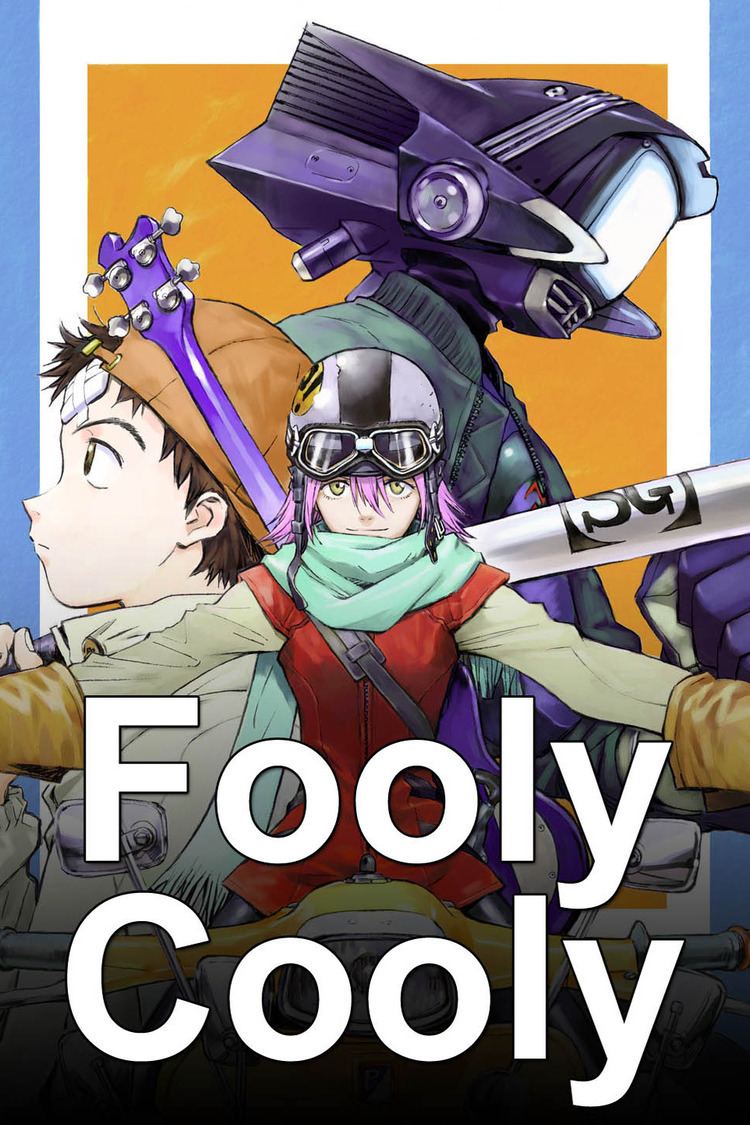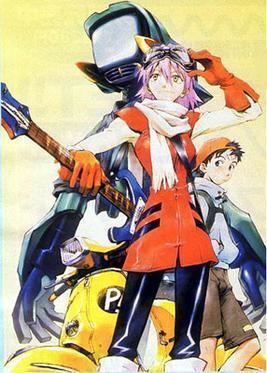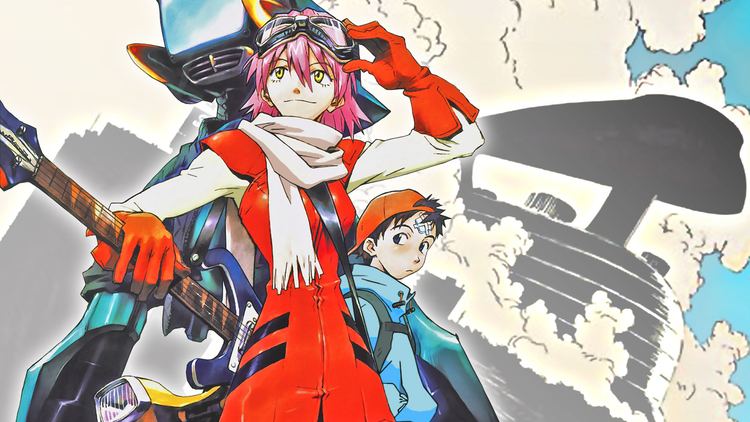8.4 /10 1 Votes8.4
8.3/10 IMDb First episode date 26 April 2000 | 8.1/10 MyAnimeList 4.5/5 Funimation | |||||||||||||||||||||||||||||||||
 | ||||||||||||||||||||||||||||||||||
Genre Action, comedy, science fiction Produced by Hiroki Sato, Nishizawa Masatomo Licensed by Madman EntertainmentFunimationMVM Films Characters Mamimi Samejima, Haruko Haruhara, Amarao, Naota Nandaba, Eri Ninamori | ||||||||||||||||||||||||||||||||||
Anime abandon flcl
FLCL (Japanese: フリクリ, Hepburn: Furi Kuri, pronounced in English as Fooly Cooly) is an original video animation (OVA) anime series written by Yōji Enokido, directed by Kazuya Tsurumaki and produced by the FLCL Production Committee, which consisted of Gainax, Production I.G, and King Records. FLCL follows Naota Nandaba, a twelve-year-old boy living in the fictional Japanese suburb of Mabase, and his interactions with Haruko Haruhara, who arrives in the quiet suburb, drawn by the industrial town houses and the Medical Mechanica building.
Contents
- Anime abandon flcl
- Plot
- Production
- Release
- Episodes
- Novels
- Manga
- Soundtracks
- Reception
- Sequel series
- References

The six-episode series was released in Japan from April 2000 to March 2001. A manga and novel were also created at the time. It aired in the United States on Adult Swim in 2003 several times. It aired once again on the network's Toonami block from October 26, 2013 to January 25, 2014. The series is also available via Hulu, iTunes, and on Funimation's website.

Two new seasons totaling 12 episodes were announced on March 24, 2016 as a co-production between Production I.G and Adult Swim.

Plot
FLCL is a coming-of-age story and revolves around Naota Nandaba, a 12-year-old, working-class boy living with his widowed father and grandfather. His life in the city of Mabase is interrupted by the arrival of Haruko Haruhara, who runs over Naota with her yellow Vespa 180 SS scooter, gives him CPR, then hits him on the head with a blue vintage Rickenbacker 4001 left-handed electric bass guitar. Naota discovers that the blow to his head created an "N.O." portal, from which giant robots produced by a company known as Medical Mechanica emerge periodically.
Naota later finds Haruko working in his house as a live-in maid. It is later discovered that Haruko is an investigator for the Galactic Space Police Brotherhood. Haruko uses Naota for her search for the Pirate King, Atomsk. She is at odds with Medical Mechanica, a monolithic industrial corporation. Naota is being watched by Commander Amarao, a special agent of the Bureau of Interstellar Immigration, who believes that Medical Mechanica is out to conquer the galaxy. Naota is ultimately drawn into a three-way battle between Haruko, Amarao and Medical Mechanica.
Production
FLCL was directed by Kazuya Tsurumaki and produced by the FLCL Production Committee, which included Gainax, Production I.G, and Starchild Records.
Tsurumaki has said that he tried to "break the rules" of anime when making FLCL, for example, by choosing a contemporary Japanese band to provide the soundtrack, and patterning the style more after "a Japanese TV commercial or promotional video", creating a work that is "short, but dense-packed".
FLCL's localization director and script writer Marc Handler stated that localization of the script was the hardest part of the show. The in-jokes in the show included obscure pop culture references that had to be decoded and transferred to English audiences. One example was a reference to Cheerio, a discontinued soft drink in Japan, for the English release the choice was made to use a discontinued American soft drink at the time, Crystal Pepsi. Director Kazuya Tsuramaki responded to criticism of FLCL, stating "comprehension should not be an important factor in FLCL."
The Medical Mechanica building featured is in the shape of a large iron. The character Amarao describes Medical Mechanica's goal as the destruction of all thought. FLCL uses the iron as a symbolic breakdown of "thought" by smoothing out the wrinkles as equated to the removing of the brain's wrinkles. For English localization, the Japanese team had to explain the concept because a direct translation of script did not convey the ideology.
Release
Six DVD compilations, each containing one episode, have been released in Japan by Gainax. In addition, a DVD collection box, containing all six DVD compilations, was released in Japan on August 13, 2005. Three DVD compilations were released by Synch-Point in North America. A DVD collection box, containing all the DVD compilations of the English episodes, was released on January 23, 2007, but have since gone out of print. In January 2010, Funimation announced that they had acquired the license for the series and would be releasing it on DVD and Blu-ray Disc in February 2011. Shortly after, it has been released in Australia and New Zealand by Madman Entertainment on a 3-disc DVD set and on Blu-ray Disc. It is also licensed in the United Kingdom by MVM Films. The series also aired in the United States on Cartoon Network's Adult Swim programming block from August 4 to August 13, 2003.
The English adaptation of the series was first licensed by Synch-Point which released the DVDs and soundtrack, but these went out of print in 2006. In January 2010, Funimation announced that they would be re-releasing the series on DVD and releasing it for the first time on Blu-ray.
Episodes
^a : The Japanese title is actually an alteration made by Haruko on the phrase "furi kuri, furi kura" (フリクリ. フリクラ). The episode's title is not meant to have any actual significance.
Novels
A three-volume novel series was written by screenwriter Yoji Enokido and published by Kadokawa Shoten. The novels were released in Japan in June 2000, October 2000, and March 2001 respectively. The English-language versions were published by Tokyopop and were released in North America on March 11, 2008; September 9, 2008; and March 10, 2009 respectively.
Manga
A two-volume manga was created by artist Hajime Ueda. The manga interprets the series with all of the key elements intact, and tells the events of the anime using a reductive art style and unsteady pacing. Jack Kotin defended the unique artstyle of the manga, saying "It can be crudely drawn at times, but this style fits in well with the overall story and atmosphere...".
The manga was published by Kodansha and serialized in monthly Magazine Z. The two volumes were released on October 23, 2000 and August 23, 2001 respectively. The manga was re-released in bunkoban format with the two volumes labeled "Jō" (上, First) and "Ge" (下, Final) in two individual box sets titled "Kodansha Box". Jō volume was on May 7, 2007 and the Ge volume was released on June 4, 2007. An edited tankōbon version of the manga that was released in box sets, were released on January 10, 2012 and February 9, 2012 respectively.
The English-language editions of the manga was released by Tokyopop on September 16, 2003 and on November 4, 2003 respectively. In March 2011, Dark Horse Comics announced to re-release the manga in omnibus edition. The omnibus edition was released on May 16, 2012 and includes remastered story pages, a remastered script, and bonus color pages.
Soundtracks
Six pieces of theme music are used for the episodes; five opening themes and one closing theme, all by the Japanese rock band, The Pillows. The battle themes are "Advice", "Little Busters" and "I Think I Can"; the opening themes are: "One Life", used in episode one, "Instant Music" in episodes two and three, "Happy Bivouac" in episode four, "Runners High", in episode five, and "Carnival" in episode six. The closing theme of each episode is "Ride on Shooting Star".
Geneon Entertainment has released three original soundtracks encompassing the songs, with the soundtracks titled, and FLCL No. 3 The remaining music was written by Shinkichi Mitsumune. Most of the music is by Japanese rock group The Pillows. The rest is by composer Shinkichi Mitsumune. The first soundtrack titled, FLCL No.1: Addict (フリクリNo.1 アディクト), contains tracks featured in the first three episodes of FLCL. The soundtrack was released on October 4, 2000 in Japan and January 20, 2004 in the US. The second soundtrack, titled FLCL No.2: King of Pirates (フリクリNo.2 海賊王, Furi Kuri No.2 Kaizoku-ō), contains tracks featured in the last three episodes of FLCL. The soundtrack was released on July 25, 2001 Japan and September 7, 2004 in the US. This volume features several audio dramas, with the cast of FLCL playing the various parts. Due to the dramas included, this album acts as a sequel of sorts to the anime. The third soundtrack, titled FLCL No.3 (フリクリNo.3), is a compilation of the first two soundtracks featuring only music by the Japanese rock group The Pillows. The released on June 8, 2005 and June 7, 2005 in the US. Unlike the previous two soundtracks, the songs are the original vocal versions from the band's LPs.
Reception
FLCL has received highly positive reviews from critics. Christopher McDonald of Anime News Network called it "downright hilarious" and "visually superb" with great music, citing the packaging of 2 episodes per DVD as the only weakness of Synch-Point's original release. Robert Nelson of T.H.E.M. Anime Reviews gave the anime 4 out of 5 stars stating, "FLCL may not have a straightforward or deep plot. It may not have complex characterizations. Hell, it may not have any meaning. But FLCL does succeed in its true objective. It is fun to watch!" Chris Beveridge of Mania gave it an A- stating, "FLCL is something that allowed those involved to try a wide variety of styles and techniques and does come off as quite experimental. But nearly everything worked in their favor and you end up with three hours of nearly break neck speed action, comedy and commentary on modern life." Brian Ruh praised the series stating, "It was very frenetic and kept pushing the envelope on what was possible in Japanese animation."
IGN columnist Davis Smith reviewed the anime shortly after its English premier, in the article Smith praised the series' unusual story telling, extremely high quality animation and the soundtrack provided by The Pillows; rewarding the series a score of 9 out of 10 concluding, "Logic dictates that FLCL should be an undisciplined and unaffecting mess, given all the insanity that its creators are attempting to weld into a functioning whole. Yet while it's hard to explain exactly why, it works. It entertains me. At times, it makes me laugh; at times, it makes me a little misty-eyed; at times, it makes me want to scream and howl and light things on fire and break windows with baseball bats and yes, maybe even buy a Vespa. That's the kind of success that you just can't argue with."
From January 3, 2012 to February 7 Hayden Childs, of the online magazine The A.V. Club, composed a six-part weekly analysis and review of each FLCL episode in celebration of The Legend of Korra's then upcoming third season, a series that was heavily influenced by FLCL animation style. In the article Childs gives an extremely positive review of the series understanding it as a surrealist inspired coming of age story stating, "For all of its wild and initially bewildering aspects, the major purpose of FLCL is the impressionistic and often naturalistic documentation of Naota’s passage into maturity."
On August 12, 2003, Time Warner press release noted the success of Cartoon Network, FLCL "ranked No. 42 among all shows on ad-supported cable among adults 18–34". Also in 2003, FLCL won third place for Best Animation Film at the Fantasia Festival. On February 24, 2007, FLCL was nominated for "Best Cast", and won "Best Comedy Series" and "Best Short Series" at the first American Anime Awards show. Anime Insider ranked FLCL 4th in their list of the best English-licensed anime of all time in November 2007. Avatar: The Last Airbender director Giancarlo Volpe says the staff "were all ordered to buy FLCL and watch every single episode of it."
Sequel series
American anime newspaper Anime News Network reported on August 31, 2015 that the production studio Production I.G. may be planning a remake of the popular series after announcing their purchase of the rights to FLCL from production company Gainax. This led many to speculate on the potential of a remake or possible continuation of the series. The IGN web series Anime Club discussed the potential of a remake with most of the participants expressing reservations towards the idea comparing it to Rebuild of Evangelion and Ghost in the Shell 2.0.
The sequel anime series was announced on March 24, 2016 via the Toonami crew's Tumblr and Facebook page that 12 new episodes of FLCL would be produced in cooperation with Production I.G. The upcoming episodes will be split into two individual seasons which will serve as sequels to the popular series which was broadcast on Adult Swim's anime block in 2003. The crew includes Neon Genesis Evangelion character designer Yoshiyuki Sadamoto and original series director Kazuya Tsurumaki. The series will premiere on Toonami either late 2017 or early 2018.
The official synopsis of the series was published by Adult Swim:
In the new season of FLCL, many years have passed since Naota and Haruhara Haruko shared their adventure together. Meanwhile, the war between the two entities known as Medical Mechanica and Fraternity rages across the galaxy. Enter Hidomi, a young teenaged girl who believes there is nothing amazing to expect from her average life, until one day when a new teacher named Haruko arrives at her school. Soon enough, Medical Mechanica is attacking her town and Hidomi discovers a secret within her that could save everyone, a secret that only Haruko can unlock.
But why did Haruko return to Earth? What happened to her Rickenbacker 4001 she left with Naota? And where did the human-type robot 'Canti' go?
Production I.G. vice president Maki Terashima-Furuta announced at the annual 2016 Anime Expo that original series character designer Yoshiyuki Sadamoto would be reprising his position for the upcoming sequel and that Psycho-Pass director Katsuyuki Motohiro would be supervising the production. Additionally, it was announced that Japanese alternative rock band The Pillows would be returning to provide the musical score for the anime.
